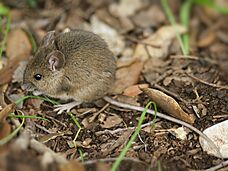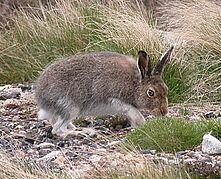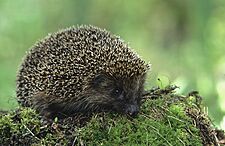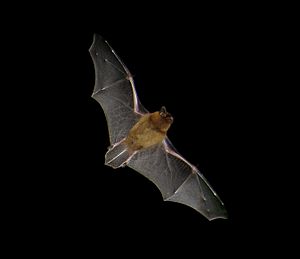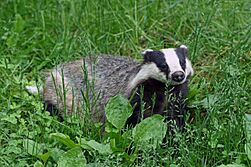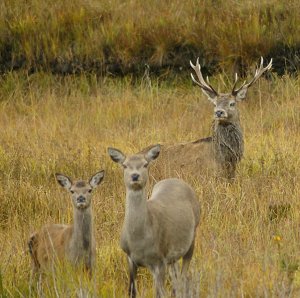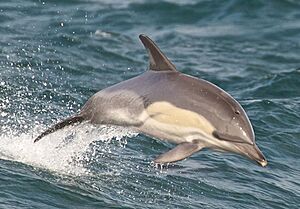List of mammals of Great Britain facts for kids
This is a list of mammals of Great Britain. The diversity of mammal fauna of Great Britain is somewhat impoverished compared to that of Continental Europe, due to the short period of time between the last ice age and the flooding of the land bridge between Great Britain and the rest of Europe. Only those land species which crossed before the creation of the English Channel and those introduced by humans exist in Great Britain.
Native (usually synonymous with "indigenous") species are considered to be species which are today present in the region in question, and have been continuously present in that region since a certain period of time. When applied to Great Britain, three possible definitions of this time constraint are:
- a species that colonised the islands during the glacial retreat at the end of the last ice age (c. 9500 years ago);
- a species that was present when the English Channel was created (c. 8000 years ago); or,
- a species that was present in prehistory.
This list includes mammals from the small islands around Great Britain and the Channel Islands. There are no endemic mammal species in Great Britain, although four distinct subspecies of rodents have arisen on small islands.
The following tags are used to highlight the conservation status of each species' British population, as assessed by Natural England and The Mammal Society in a Regional Red List, following the criteria of the International Union for Conservation of Nature.
| Extinct | No reasonable doubt that the last individual has died. | |
| Extinct in the wild | Known only to survive in captivity or as a naturalised population well outside its previous range. | |
| Critically endangered | The species is in imminent risk of extinction in the wild. | |
| Endangered | The species is facing an extremely high risk of extinction in the wild. | |
| Vulnerable | The species is facing a high risk of extinction in the wild. | |
| Near threatened | The species does not meet any of the criteria that would categorise it as risking extinction but it is likely to in the future. | |
| Least concern | There are no current identifiable risks to the species. | |
| Data deficient | There is inadequate information to make an assessment of the risks to this species. |
Contents
Diprotodonts
Order: Diprotodontia
Although marsupials are primarily found in the Australian region, the red-necked wallaby has been introduced to parts of Great Britain. Feral populations breed on the island of Inchconnachan on Loch Lomond in Argyll and Bute, Scotland, and on the Isle of Man. Other colonies have existed in Devon, the Peak District, and the Ashdown Forest in East Sussex, and although these are now believed to be locally extinct, occasional sightings continue.
Family: Macropodidae (kangaroos, wallabies, and kin)
- Red-necked wallaby, Notamacropus rufogriseus introduced
Rodents
Order: Rodentia
Rodents are the largest order of mammals, comprising 40% of all species. They are characterised by a single pair of continuously growing incisors in each of the upper and lower jaws and are native to almost all major landmasses on Earth.
Family: Castoridae (beavers)
- Eurasian beaver, Castor fiber globally, in Great Britain, reintroduced
Family: Cricetidae (hamsters, voles, and kin)
- European water vole, Arvicola amphibius globally, in Great Britain
- Short-tailed field vole, Microtus agrestis
- Common vole, Microtus arvalis
- Orkney vole, M. a. orcadensis
- Bank vole, Myodes glareolus
Family: Muridae (mice, rats, and kin)
- Yellow-necked mouse, Apodemus flavicollis
- Wood mouse, Apodemus sylvaticus
- St Kilda field mouse, A. s. hirtensis
- Eurasian harvest mouse, Micromys minutus
- House mouse, Mus musculus
- St Kilda house mouse, M. m. muralis c. 1930
- Brown rat, Rattus norvegicus introduced
- Black rat, Rattus rattus introduced
Family: Gliridae (dormice)
- European edible dormouse, Glis glis introduced
- Hazel dormouse, Muscardinus avellanarius globally, in Great Britain
Family: Sciuridae (squirrels)
- Eastern gray squirrel, Sciurus carolinensis introduced
- Red squirrel, Sciurus vulgaris globally, in Great Britain
Lagomorphs
Order: Lagomorpha
The lagomorphs comprise two families, Leporidae (hares and rabbits), and Ochotonidae (pikas). Although they can resemble rodents, and were classified as a superfamily in that order until the early 20th century, they have since been considered a separate order. They differ from rodents in a number of physical characteristics, such as having four incisors in the upper jaw rather than two.
Family: Leporidae (rabbits and hares)
- European hare, Lepus europaeus introduced
- Mountain hare, Lepus timidus
- European rabbit, Oryctolagus cuniculus introduced
Eulipotyphlans
Order: Eulipotyphla
The order Eulipotyphla contains insectivorous mammals. Hedgehogs are easily recognised by their spines, while gymnures look more like large rats. Shrews and solenodons closely resemble mice, while moles are stout-bodied burrowers.
Family: Talpidae (moles)
- European mole, Talpa europaea
Family: Soricidae (shrews)
- Lesser white-toothed shrew, Crocidura suaveolens
- Eurasian water shrew, Neomys fodiens
- Common shrew, Sorex araneus
- Eurasian pygmy shrew, Sorex minutus
Family: Erinaceidae (hedgehogs and moonrats)
- European hedgehog, Erinaceus europaeus globally, in Great Britain
Bats
Order: Chiroptera
Bats' most distinguishing feature is that their forelimbs are developed as wings, making them the only mammals capable of flight. Bat species account for about 20% of all mammals.
Family: Rhinolophidae (horseshoe bats)
- Lesser horseshoe bat, Rhinolophus hipposideros
- Greater horseshoe bat, Rhinolophus ferrumequinum
Family: Vespertilionidae (common bats, vesper bats, and kin)
- Western barbastelle, Barbastella barbastellus globally, in Great Britain
- Serotine bat, Eptesicus serotinus globally, in Great Britain
- Bechstein's bat, Myotis bechsteini
- Brandt's bat, Myotis brandti
- Daubenton's bat, Myotis daubentoni
- Greater mouse-eared bat, Myotis myotis globally, or possibly extirpated in Great Britain
- Whiskered bat, Myotis mystacinus
- Natterer's bat, Myotis nattereri
- Lesser noctule, Nyctalus leisleri
- Common noctule, Nyctalus noctula
- Nathusius pipistrelle, Pipistrellus nathusii
- Common pipistrelle, Pipistrellus pipistrellus
- Soprano pipistrelle, Pipistrellus pygmaeus
- Brown long-eared bat, Plecotus auritus
- Grey long-eared bat, Plecotus austriacus globally, in Great Britain
- Parti-coloured bat, Vespertilio murinus
Carnivorans
Order: Carnivora
There are over 260 species of carnivorans, the majority of which feed primarily on meat. They have a characteristic skull shape and dentition.
Family: Canidae (dogs)
- Red fox, Vulpes vulpes
Family: Mustelidae (weasels, badgers, and kin)
- Asian small-clawed otter, Aonyx cinereus introduced
- Eurasian otter, Lutra lutra
- European pine marten, Martes martes
- European badger, Meles meles
- Stoat, Mustela erminea ,
- Least weasel, Mustela nivalis
- European polecat, Mustela putorius
- American mink, Neogale vison introduced
Family: Felidae (cats)
- European wildcat, Felis silvestris globally, in Great Britain
- Scottish wildcat, F. s. silvestris
Family: Phocidae (earless seals)
- Grey seal, Halichoerus grypus
- Harbour seal, Phoca vitulina
Even-toed ungulates
Order: Artiodactyla
The even-toed ungulates are ungulates whose weight is borne about equally by the third and fourth toes, rather than mostly or entirely by the third as in perissodactyls. There are about 220 artiodactyl species, including many that are of great economic importance to humans. Cetaceans are also considered to be even-toed ungulates for phylogenetic reasons.
Family: Suidae (pigs)
- Wild boar, Sus scrofa reintroduced
Family: Cervidae (deer)
- Roe deer, Capreolus capreolus
- Siberian roe deer, Capreolus pygargus , introduced, extirpated
- Red deer, Cervus elaphus
- Scottish red deer, C. e. scoticus
- Sika deer, Cervus nippon introduced
- European fallow deer, Dama dama introduced
- Water deer, Hydropotes inermis introduced
- Reeves's muntjac, Muntiacus reevesi introduced
Family: Bovidae (cattle, bison, and kin)
- European bison, Bison bonasus reintroduced
Whales and dolphins
Order: Cetacea
The order Cetacea includes whales, dolphins and porpoises. They are the mammals most fully adapted to aquatic life: they have a spindle-shaped, nearly hairless body, protected by a thick layer of blubber, and forelimbs and tail modified to provide propulsion underwater.
Family: Balaenidae (right whales and bowhead whales)
- North Atlantic right whale, Eubalaena glacialis globally, possibly extant in Great Britain
Family: Balaenopteridae (rorquals)
- Common minke whale, Balaenoptera acutorostrata
- Sei whale, Balaenoptera borealis
- Blue whale, Balaenoptera musculus
- Fin whale, Balaenoptera physalus
- Humpback whale, Megaptera novaeangliae
Family: Phocoenidae (porpoises)
- Harbour porpoise, Phocoena phocoena globally, in Europe
Family: Physeteridae (sperm whales)
- Sperm whale, Physeter macrocephalus
Family: Kogiidae (pygmy and dwarf sperm whales)
- Pygmy sperm whale, K. breviceps
Family: Ziphiidae (beaked whales)
- Cuvier's beaked whale, Ziphius cavirostris
- Northern bottlenose whale, Hyperoodon ampullatus
- Sowerby's beaked whale, Mesoplodon bidens
- Gervais' beaked whale, Mesoplodon europaeus
- True's beaked whale, Mesoplodon mirus
Family: Delphinidae (oceanic dolphins)
- White-beaked dolphin, Lagenorhynchus albirostris
- Atlantic white-sided dolphin, Lagenorhynchus acutus
- False killer whale, Pseudorca crassidens
- Common dolphin, Delphinus delphis
- Common bottlenose dolphin, Tursiops truncatus
- Striped dolphin, Stenella coeruleoalba
- Risso's dolphin, Grampus griseus
- Orca, Orcinus orca
Locally extinct
- Eurasian elk, Alces alces
- Grey wolf, Canis lupus
- Wolverine, Gulo gulo
- Eurasian lynx, Lynx lynx
- Reindeer, Rangifer tarandus
- Brown bear, Ursus arctos
See also
- Biota of the Isle of Man
- List of endemic species of the British Isles
- List of extinct animals of the British Isles
- List of mammals of Ireland



